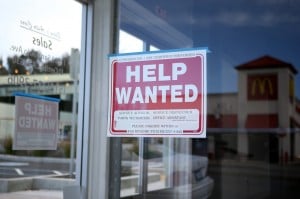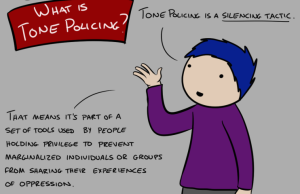
A red “help wanted” sign on a store window. Source: CBS Sacramento
Like it or not, we live in a capitalist society: Everyone is dependent on money in order to survive.
We often discuss class as if it is independent from other forms of oppression. (Think Occupy Wall Street.) But while it’s not usually talked about as a feminist issue, class is at the heart of feminist work; one’s economic power, after all, is central to their well-being.
So here are seven reasons why class is a feminist issue:
1. Classism Enables the Status Quo
Money is really important.
As I previously mentioned, living in a capitalism society means that we all need to have some sort of access to money in order to meet our basic needs. Even though food, water, and shelter might seem like human rights, in reality, they aren’t a guarantee.
That means that we have to spend the majority, if not all, of our lives are spent in pursuit of money. We’re focused on labor instead of on planning the revolution.
The class you’re born into is usually the class you will remain in for life, especially if you’re poor or working class. With the gap between the rich and poor growing in the US to its highest levels of inequality ever, this means that those who are born with monetary power will stay there.
This makes it awfully hard to change the culture. As feminists, we’re all about upsetting the status quo, so we should definitely pay attention to anything that makes doing so more difficult.
2. Class Works Hand-in-Hand With Sexism
Women are disproportionately poorer and are found to be in poverty more often than men. This is true across racial and ethnic lines, but women of color face higher rates of poverty than white women and are twice as likely to be in poverty.
Women also make less money than men for doing the same work (yes, even when factors such as hours worked are controlled). In 2012, women who were employed full-time earned 77 cents for every dollar earned by a man. Accounting for race, black women only earn 64 cents to every white man’s dollar; Latinas, only 53 cents.
When women have lower economic standing, they have less power and autonomy across all areas of their lives. Money, after all, is power.
Women become more dependent on partners and (sometimes nonexistent) social systems to meet their financial needs. Single women also have a greater need than men for a second income, which means less time for leisure, self-care, and smashing the patriarchy.
If you care about sexism, you should care about classism.
3. Class Works Hand-in-Hand With Racism
People of color are disproportionately in poverty, compared to their white counterparts. Poverty rates for black and Latinx Americans are much higher than the national average: in 2010, 27.4% of black and 26.6% of Latinx Americans were poor, compared to only 9.9% of white Americans.
The effects of classism for people of color are felt directly, but classism also affects their lives in many indirect ways. For instance, communities of color are more often located near coal power plants where rent is cheaper; proximity to these plants has been linked to negative health outcomes due to air pollution.
Speaking of housing, that’s another issue where race and class work together to discriminate against people of color. Gentrification, disproportionate rejection as tenets, and segregation are just a few of the class issues people of color face in this area.
Housing also has massive effects on the quality of life, as it often determines opportunity (both extracurricular and employment), exposure to crime, and education (thanks to the classist and racist policies that use property taxes to fund schools).
If feminists truly wants to address the complexities of racism, we need to discuss classism.
4. ‘Women’s Work’ Is Undervalued and Underpaid
In the capitalist system that we live in, women perform the majority of the unpaid labor: childcare, cleaning, cooking, and running a household.
According to the US Census Bureau, women do more than 110 million hours a year of this labor, while men clock in at around 55 million.
One study found that if unpaid labor was accounted for, the national gross domestic product in the United States would rise from $352 million to $504 billion. That’s the difference between poverty and sustainable living for the women doing this labor.
Women who are over the age of 65 are twice as likely to be in poverty than men of the same age and one important reason is that the majority of these women were, or are currently, unpaid caregivers to their spouses and/or children.
This work is often expected of women; even those who work full-time still take on the majority of this unpaid work.
These societal expectations based in sexism are intimately linked to classism, as they keep women in poverty.
5. Those Who Are Disabled Are Often Forced into Poverty
People with disabilities have many more limitations on earning income and also often need more money for medical expenses than the non-disabled. Living with someone who is disabled can also drive the entire household into poverty.
People with disabilities disproportionately live in poverty, often thanks to being underrepresented in employment and higher education. In 2006, the median income for individuals with a disability was $17,000, compared with $28,000 for those who are able-bodied.
Even though the ADA requires that employers not discriminate based on ability, the policy often goes unmonitored. One 2008 study showed that employers held negative perceptions about the productivity of people with disabilities.
What causes these disproportions? The structure of our current class system.
Because we value types of labor that able-bodied people can perform, the employment options for disabled people are slim pickings.
Also, because of a lack of adequate public healthcare, disabled people are often forced to pay for their needed care out of pocket.
This system is actively working against them.
6. Feminism Has a Class Problem
…In case you weren’t aware.
Have you ever noticed how the most prominent feminists are usually financially stable (often rich) women?
Me, too.
Doing activist work requires a lot of time, energy, and effort. So it follows that those who have less time and energy (the working poor, those who are forced to work more than one job, single mothers) are not able to work on advocacy.
Being able to be a “professional” feminist is a privilege — class privilege, to be specific.
We need to start dismantling the structures that enable this class problem to perpetuate itself.
Which leads me to…
7. Class Is Deeply Connected to Patriarchy
So the structure that I was referring to was patriarchy; more specifically, hegemonic capitalist patriarchy.
Patriarchy keeps our class system in place by enabling those in power to stay in power and those without power to stay in the margins.
Have you ever seen the income inequality between the rich and everyone else? It’s astounding — and it’s growing. In 2012, those in the top 10% of earners in America took home more than half of all income. That is the highest proportion in American history!
Because our system allows rich people to stay rich, while simultaneously keeping everyone else down, the power structure stays in place — meaning old, rich, able-bodied, cisgender, heterosexual white men.
This is why fighting classism is so deeply rooted in feminism: because classism is one of the most powerful tools of oppression in the patriarchy’s arsenal . And feminism is all about fighting against that.
***
Clearly, classism is worthy of our attention.
It’s connected to so many of the other forms of oppression that exist and not only does it allow these inequalities to exist, but it helped to create them in the first place.
So let’s fight the power. Here are some ways you can work (no pun intended) to end classism:
1. Stop Stereotyping
Those without class privilege include people from a wide range of experiences and backgrounds.
Don’t rely on tired stereotypes like “hillbilly” or “welfare queen” to describe them.
2. Challenge Organizations That Have Internal Structures of Classism
You can use this document as a guide for how to challenge the often classist structure of many nonprofits and social justice organizations.
3. Invest Wisely
Try to use the money you do have for good.
Consider joining a credit union instead of a large bank, donating to local community organizations, shopping at farmers’ markets or companies that don’t exploit workers.
4. Take a Stand
Start a protest, join or create an organization, start a petition, blog.
Do something to stand up to classism. Here is a list of ideas to get you started.
What are some actions you are going to take to end classism?
[do_widget id=”text-101″]
Erin McKelle is a Contributing Writer for Everyday Feminism. She’s an e-activist, video blogger, student, and non-profit advocate who has launched several projects, including Fearless Feminism and Consent is Sexy. In her spare time, Erin enjoys reading, writing bad poetry, drawing, politics and reality TV. You can visit her site here find her blogging at Fearless Feminism, Facts About Feminism, and Period Positive. Follow her on Twitter @ErinMckelle and read her articles here.
Search our 3000+ articles!
Read our articles about:
Our online racial justice training
Used by hundreds of universities, non-profits, and businesses.
Click to learn more




















